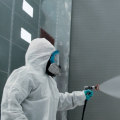House paint and canvas may seem like an unconventional pairing, but the combination is not entirely unheard of in the art world, particularly for DIY projects or large-scale works. However, the question of whether house paint cracks on canvas is one that requires a nuanced understanding of the properties of both the paint and the substrate. Canvas, typically made from cotton or linen and stretched over a wooden frame, is a flexible material that reacts to environmental conditions such as humidity and temperature. House paint, on the other hand, is designed for rigid surfaces like walls, where it can dry and cure without the need for flexibility. The interaction between these two materials can result in cracking, peeling, or other issues over time, especially if proper techniques are not followed. This knowledge is especially important for creative projects or practical applications, like using house paint for murals or decorative elements when getting a pole barn built, where materials and durability must be carefully considered.
The Properties of House Paint
House paint is formulated to withstand the wear and tear of home interiors or exteriors. It is designed to adhere to stable, rigid surfaces such as drywall, wood, or masonry, and its primary function is to provide coverage, color, and protection. Most house paints, whether latex or oil-based, contain resins that cure into a hard, durable finish when exposed to air. This hardness is a strength when applied to walls, but it becomes a liability when used on flexible materials like canvas, as the rigidity of the paint does not accommodate the movement of the fabric.
The Behavior of Canvas
Canvas is a lightweight, flexible surface that expands and contracts depending on environmental conditions. It is highly responsive to humidity, stretching slightly when damp and tightening when dry. This characteristic makes it an excellent choice for traditional art mediums like acrylic and oil paints, which are formulated to move with the canvas and resist cracking. House paint, however, lacks this flexibility, making it prone to cracking when the canvas shifts.
When house paint dries on canvas, it creates a brittle layer that can fracture with movement or changes in tension. Over time, the cracks may expand, especially if the painted canvas is rolled, folded, or exposed to fluctuating temperatures. While the paint might initially adhere well to the canvas, its long-term durability depends on the conditions it is subjected to.
Techniques to Minimize Cracking
To reduce the likelihood of cracking, certain precautions can be taken when using house paint on canvas. Priming the canvas with gesso creates a smoother, more rigid surface for the paint to adhere to, reducing the tension between the two materials. Choosing a high-quality latex house paint with some flexibility can also help, as these paints are less likely to become excessively brittle.
Another important factor is the application method. Applying thin, even layers of paint allows for better adhesion and reduces the stress placed on the canvas. Avoiding overly thick applications is crucial, as heavier layers of paint are more prone to cracking when the canvas shifts. Ensuring that the painted canvas remains stretched tightly and stored in a stable environment can further extend the lifespan of the project.
When House Paint on Canvas Works
There are situations where house paint on canvas can be both functional and visually effective. For instance, house paint is often used in large-scale murals or outdoor installations due to its affordability and range of colors. In these cases, the canvas is typically adhered to a rigid surface, such as a wall or frame, eliminating the movement that would otherwise lead to cracking.
Artists and crafters also use house paint on canvas for temporary projects or experimental works where longevity is not a priority. For such applications, the cost-effectiveness and accessibility of house paint make it an attractive option despite its limitations.
The Connection to Practical Projects
For practical projects, understanding material compatibility is essential. While house paint might not be suitable for flexible canvas, its durability and affordability make it ideal for painting rigid structures or large flat surfaces. In situations where decorative elements are incorporated into a pole barn’s design, such as canvas banners or signs, it’s important to choose the right type of paint for the specific materials used. These considerations ensure that both aesthetic and functional goals are met without compromising the longevity of the work.
Conclusion
House paint can crack on canvas due to its rigidity and lack of flexibility, which are incompatible with the dynamic nature of canvas as a substrate. While it is possible to minimize cracking with proper preparation and techniques, the inherent differences between these materials make house paint a less-than-ideal choice for projects requiring durability and long-term stability. For creative or practical applications, understanding these limitations helps ensure that the right materials are chosen for the task at hand. Whether you’re creating artwork, decorating a space, or embarking on larger-scale projects like getting a pole barn built, selecting the appropriate paint and surface combination is essential to achieving lasting results.






